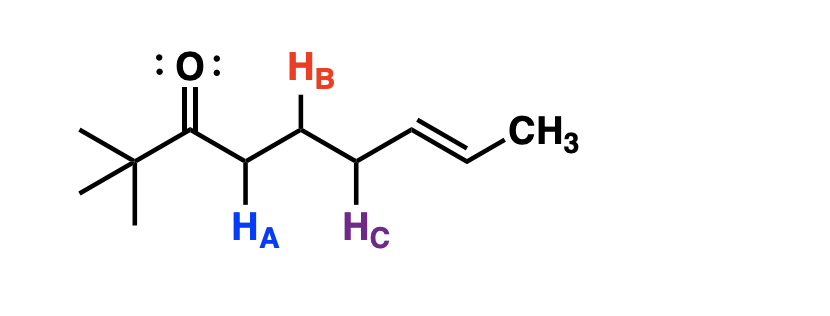Chemistry
10th Edition
ISBN:9781305957404
Author:Steven S. Zumdahl, Susan A. Zumdahl, Donald J. DeCoste
Publisher:Steven S. Zumdahl, Susan A. Zumdahl, Donald J. DeCoste
Chapter1: Chemical Foundations
Section: Chapter Questions
Problem 1RQ: Define and explain the differences between the following terms. a. law and theory b. theory and...
Related questions
Question
Which proton has the lowest pKa, proton A, proton B, and proton C?

Transcribed Image Text:The image displays the chemical structure of an unsaturated ketone with various labeled hydrogen atoms. The molecular structure is represented in a skeletal formula, commonly used to simplify organic molecules.
### Explanation of the Structure:
1. **Main Carbon Chain (Backbone):**
- The backbone consists of a seven-carbon chain.
- It includes both single and double covalent bonds, with the first five carbons forming single bonds and a double bond between the sixth and seventh carbons.
2. **Functional Group:**
- There is a ketone functional group present on the second carbon atom from the left. It is represented by a carbonyl group (\(C=O\)), where the oxygen is double-bonded to the carbon.
3. **Substituents and Hydrogen Atoms:**
- A methyl group (\(CH_3\)) is attached to the sixth carbon, represented as branching off from the main chain.
- Three types of hydrogen atoms are highlighted:
- \(H_A\) is the hydrogen atom on the third carbon.
- \(H_B\) is the hydrogen atom on the fourth carbon.
- \(H_C\) is the hydrogen atom on the fifth carbon.
4. **Notation:**
- The hydrogen atoms are differentiated by color and subscript letters (A, B, C) to denote their specific environments or relevance in a study or reaction mechanism.
This structural depiction is crucial for understanding the molecular geometry and chemical behavior of the compound in areas such as organic chemistry and related applications.
Expert Solution
Step 1: Interpretation of given problem
Given is organic compound.

Step by step
Solved in 3 steps with 1 images

Knowledge Booster
Learn more about
Need a deep-dive on the concept behind this application? Look no further. Learn more about this topic, chemistry and related others by exploring similar questions and additional content below.Recommended textbooks for you

Chemistry
Chemistry
ISBN:
9781305957404
Author:
Steven S. Zumdahl, Susan A. Zumdahl, Donald J. DeCoste
Publisher:
Cengage Learning

Chemistry
Chemistry
ISBN:
9781259911156
Author:
Raymond Chang Dr., Jason Overby Professor
Publisher:
McGraw-Hill Education

Principles of Instrumental Analysis
Chemistry
ISBN:
9781305577213
Author:
Douglas A. Skoog, F. James Holler, Stanley R. Crouch
Publisher:
Cengage Learning

Chemistry
Chemistry
ISBN:
9781305957404
Author:
Steven S. Zumdahl, Susan A. Zumdahl, Donald J. DeCoste
Publisher:
Cengage Learning

Chemistry
Chemistry
ISBN:
9781259911156
Author:
Raymond Chang Dr., Jason Overby Professor
Publisher:
McGraw-Hill Education

Principles of Instrumental Analysis
Chemistry
ISBN:
9781305577213
Author:
Douglas A. Skoog, F. James Holler, Stanley R. Crouch
Publisher:
Cengage Learning

Organic Chemistry
Chemistry
ISBN:
9780078021558
Author:
Janice Gorzynski Smith Dr.
Publisher:
McGraw-Hill Education

Chemistry: Principles and Reactions
Chemistry
ISBN:
9781305079373
Author:
William L. Masterton, Cecile N. Hurley
Publisher:
Cengage Learning

Elementary Principles of Chemical Processes, Bind…
Chemistry
ISBN:
9781118431221
Author:
Richard M. Felder, Ronald W. Rousseau, Lisa G. Bullard
Publisher:
WILEY